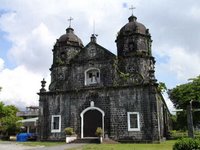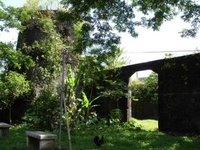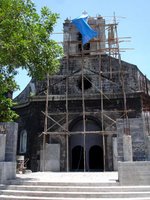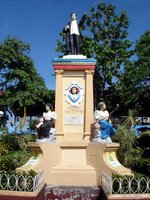I had a pinangat overload in Albay last week! Who doesn't love pinangat or laing? Pinangat is a Bicolano dish made from taro (gabi) leaves, chili (siling labuyo), meat or dried fish and coconut milk. Camalig is very popular for pinangat especially since there are so many stores along the National Highway selling freshly-cooked or frozen pinangat to take home.
We stopped by Dad's Pinangat where a serving costs Php40 each. There are two types, one with chili and one without. I tried the freshly-cooked pinangat which was really good. I noticed though when I tried the frozen one at home that it wasn't as flavorful. This pinangat version has dried fish, maybe daing.
While in Camalig, make sure to visit the centuries-old Camalig Church.
Back in Legazpi, I made sure to visit Small Talk Cafe to try out their laing pizza. Order the Bicolana, which is pizza topped with pinangat, pineapple chunks, mushrooms and mozarella. The crust was thin and crunchy, and the combination worked well. The flavor of the laing was quite subtle. At Php225, it's a steal!
They also have Pasta Mayon (pinangat ravioli in red tuna sauce), Pasta Pinangat (pinangat and coconut milk in white sauce with pasta), and Bicol Express Pasta (alamang, sili and gata sautéed in garlic and pasta) which I all got to try since the prices were quite affordable (Php105 to Php110 per serving). They also have Pili Basil Pasta (Php120).
I had written something on the Mayon Volcano, Cagsawa Ruins and Daraga Church previously. My favorite views of the Mayon Volcano are from Lignon Hill, Cagsawa Ruins (which is the iconic view of the volcano) and Daraga Church (especially if you take a photo of the church with the volcano behind it). But waking up to a beautiful morning with a clear view of Mayon Volcano was another great experience. The photo at the top was taken from my room balcony at the Oriental Hotel Legazpi.
We stopped by Dad's Pinangat where a serving costs Php40 each. There are two types, one with chili and one without. I tried the freshly-cooked pinangat which was really good. I noticed though when I tried the frozen one at home that it wasn't as flavorful. This pinangat version has dried fish, maybe daing.
While in Camalig, make sure to visit the centuries-old Camalig Church.
Back in Legazpi, I made sure to visit Small Talk Cafe to try out their laing pizza. Order the Bicolana, which is pizza topped with pinangat, pineapple chunks, mushrooms and mozarella. The crust was thin and crunchy, and the combination worked well. The flavor of the laing was quite subtle. At Php225, it's a steal!
They also have Pasta Mayon (pinangat ravioli in red tuna sauce), Pasta Pinangat (pinangat and coconut milk in white sauce with pasta), and Bicol Express Pasta (alamang, sili and gata sautéed in garlic and pasta) which I all got to try since the prices were quite affordable (Php105 to Php110 per serving). They also have Pili Basil Pasta (Php120).
I had written something on the Mayon Volcano, Cagsawa Ruins and Daraga Church previously. My favorite views of the Mayon Volcano are from Lignon Hill, Cagsawa Ruins (which is the iconic view of the volcano) and Daraga Church (especially if you take a photo of the church with the volcano behind it). But waking up to a beautiful morning with a clear view of Mayon Volcano was another great experience. The photo at the top was taken from my room balcony at the Oriental Hotel Legazpi.































